- Drag drop about BGP
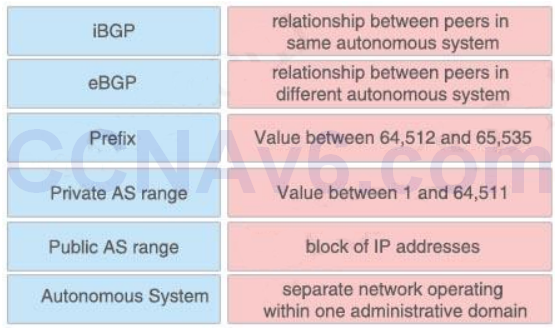
Answer:
iBGP <-> relationship between peers in same autonomous system
eBGP <-> relationship between peers in different autonomous system
Prefix <-> block of IP addresses
Private AS range <-> Value between 64,512 and 65,535
Public AS range <-> Value between 1 and 64,511
Autonomous System <-> separate network operating within one administrative domain - Drag the options below unto the planes they operate
Control Plane and Data Plane
Control Plane:
3. Routing state exchange
4. Establishes telnet session
5. Device accessData Plane:
1. QoS
2. Filtering
6. Data EncapsulationShow (Hide) Explanation/ReferenceThe control plane: The control plane is the brain of the router. It consists of dynamic IP routing protocols (that is OSPF, IS-IS, BGP, and so on), the RIB, routing updates, in addition to other protocols such as PIM, IGMP, ICMP, ARP, BFD, LACP, and so on. In short, the control plane is responsible for maintaining sessions and exchanging protocol information with other router or network devices.The data plane: The data plane is the forwarding plane, which is responsible for the switching of packets through the router (that is, process switching and CEF switching). In the data plane, there could be features that could affect packet forwarding such as quality of service (QoS) and access control lists (ACLs).
Reference: http://www.ciscopress.com/articles/article.asp?p=2272154&seqNum=3
- Drag drop about Cable types.
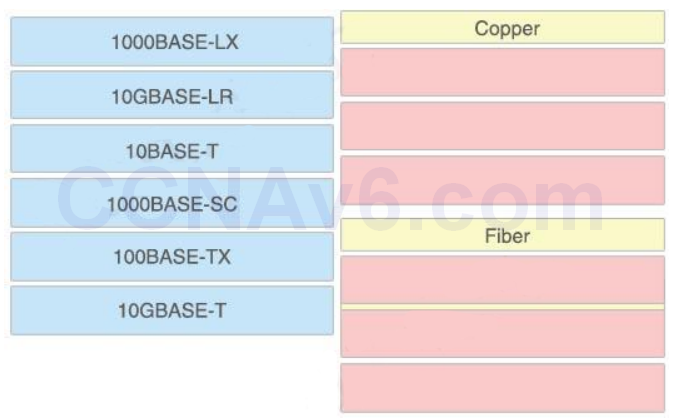
Answer:
Copper:
+ 10BASE-T
+ 100BASE-TX
+ 10GBASE-TFiber:
+ 10GBASE-LR
+ 1000BASE-LX
+ 1000BASE-SCShow (Hide) Explanation/ReferenceThe “T” letter symbolizes for “twisted pair cable” so all “BASE-T…” types are copper. - Drag drop about QoS.
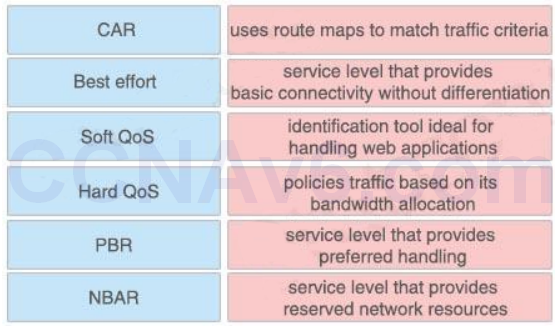
Answer:
+ CAR: policies traffic based on its bandwidth allocation
+ Best effort: service level that provides basic connectivity without differentiation
+ Soft QoS: service level that provides preferred handling
+ Hard QoS: service level that provides reserved network resources
+ PBR: uses route maps to match traffic criteria
+ NBAR: identification tool ideal for handling web applicationsNote:
+ Committed Access Rate (CAR)
+ Network-based application recognition (NBAR)
+ Policy-based routing (PBR)
+ Soft QoS: also known as Differentiated Services (Diffserv), which ensures resources for
applications based on available bandwidth
+ Hard QoS: Differentiated Service (DiffServ) is an appropriate example for this type of QoS service - Drag and drop the DHCP client states from the left into the standard order in which the client passes through them on the right.
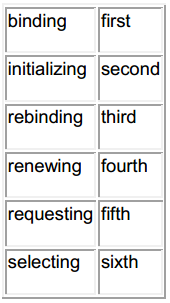
Answer:
initializing – first
selecting – second
requesting – third
binding – fourth
renewing – fifth
rebinding – sixth - Drag the term on the left to its definition on the right (not all options are used)
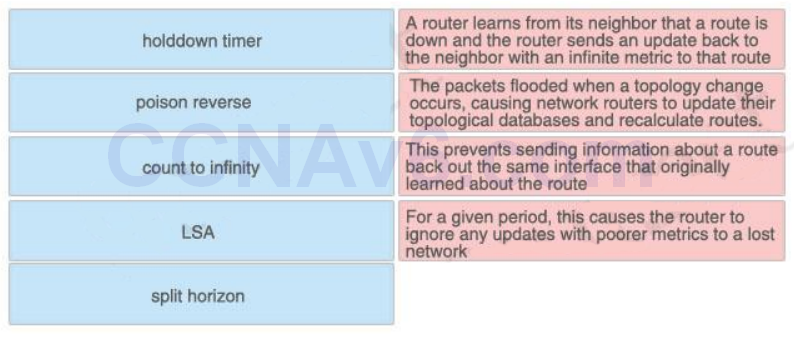
Answer:
+ poison reverse: A router learns from its neighbor that a route is down and the router sends an
update back to the neighbor with an infinite metric to that route
+ LSA: The packets flooded when a topology change occurs, causing network routers to update their
topological databases and recalculate routes
+ split horizon: This prevents sending information about a route back out the same interface that
originally learned about the route
+ holddown timer: For a given period, this causes the router to ignore any updates with poorer
metrics to a lost network - Drag and drop the extended traceroute options from the left onto the correct description on the right.
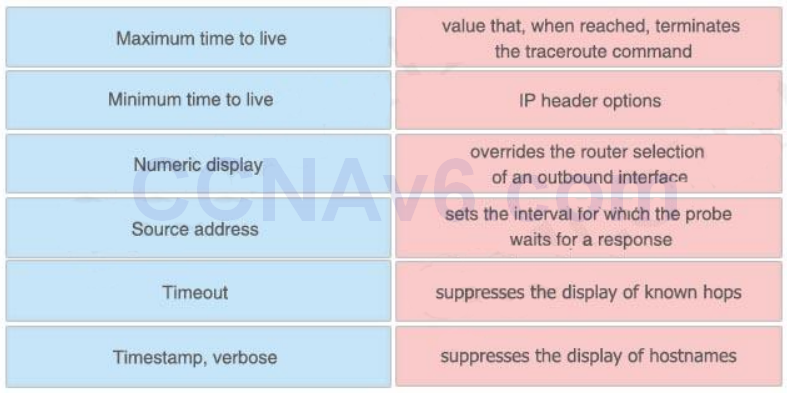
Answer:
+ Maximum time to live: value that, when reached, terminates the traceroute command
+ Minimum time to live: suppresses the display of hostnames
+ Numeric display: suppresses the display of known hops
+ Source address: overrides the router selection of an outbound interface
+ Timeout: sets the interval for which the probe waits for a response
+ Timestamp, verbose: IP header optionsShow (Hide) Explanation/ReferenceMinimum Time to Live: The TTL value for the first probes. The default is 1, but it can be set to a higher value to suppress the display of known hops.
Numeric display: The default is to have both a symbolic and numeric display; however, you can suppress the symbolic display. - Drag and drop the items on the right to the correspondent definitions on the left.
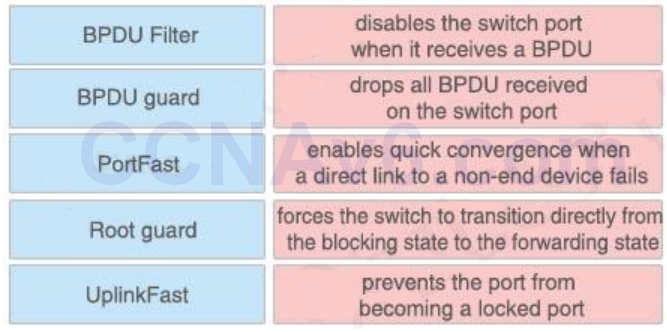
Answer:
+ BPDU Filter: drops all BPDU received on the switch port
+ BPDU guard: disables the switch port when it receives a BPDU
+ PortFast: forces the switch to transition directly from the blocking state to the forwarding state
+ Root guard: prevents the port from becoming a locked port
+ UplinkFast: enables quick convergence when a direct link to a non-end device fails - Drag and drop the values in a routing table from the left onto the correct meanings on the right
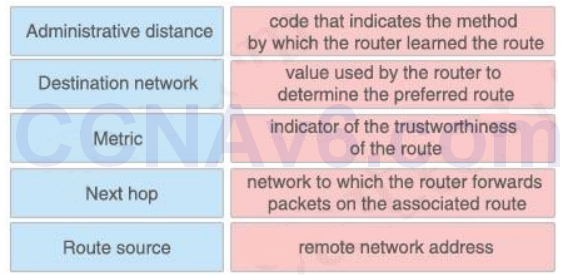
Answer:
+ Administrative distance: indicator of the trustworthiness of the route
+ Destination network: remote network address
+ Metric: value used by the router to determine the preferred route
+ Next hop: network to which the router forwards packets on the associated route
+ Route source: code that indicates the method by which the router learned the route - Drag and drop the CSMA components from the left onto the correct descriptions on the right
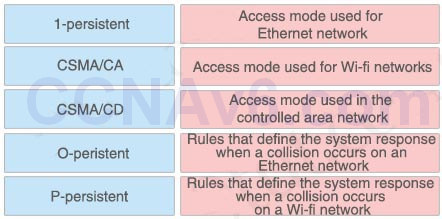
Answer:
+ 1-persistent: Access mode used for Ethernet network
+ CSMA/CA: Rules that define the system response when a collision occurs on a Wi-fi network
+ CSMA/CD: Rules that define the system response when a collision occurs on an Ethernet network
+ O-peristent: Access mode used in the controlled area network
+ P-persistent: Access mode used for Wi-fi networksShow (Hide) Explanation/Reference1-persistent CSMA is an aggressive transmission algorithm. When the transmitting node is ready to transmit, it senses the transmission medium for idle or busy. If idle, then it transmits immediately. If busy, then it senses the transmission medium continuously until it becomes idle, then transmits the message (a frame) unconditionally (i.e. with probability=1). In case of a collision, the sender waits for a random period of time and attempts the same procedure again. 1-persistent CSMA is used in CSMA/CD systems including Ethernet.Non persistent CSMA is a non aggressive transmission algorithm. When the transmitting node is ready to transmit data, it senses the transmission medium for idle or busy. If idle, then it transmits immediately. If busy, then it waits for a random period of time (during which it does not sense the transmission medium) before repeating the whole logic cycle (which started with sensing the transmission medium for idle or busy) again. This approach reduces collision, results in overall higher medium throughput but with a penalty of longer initial delay compared to 1–persistent.
P-persistent is an approach between 1-persistent and non-persistent CSMA access modes. [1]When the transmitting node is ready to transmit data, it senses the transmission medium for idle or busy. If idle, then it transmits immediately. If busy, then it senses the transmission medium continuously until it becomes idle, then transmits with probability p. If the node does not transmit (the probability of this event is 1-p), it waits until the next available time slot. If the transmission medium is not busy, it transmits again with the same probability p. This probabilistic hold-off repeats until the frame is finally transmitted or when the medium is found to become busy again (i.e. some other node has already started transmitting). In the latter case the node repeats the whole logic cycle (which started with sensing the transmission medium for idle or busy) again. p-persistent CSMA is used in CSMA/CA systems including Wi-Fi and other packet radio systems.
O-persistent
Each node is assigned a transmission order by a supervisory node. When the transmission medium goes idle, nodes wait for their time slot in accordance with their assigned transmission order. The node assigned to transmit first transmits immediately. The node assigned to transmit second waits one time slot (but by that time the first node has already started transmitting). Nodes monitor the medium for transmissions from other nodes and update their assigned order with each detected transmission (i.e. they move one position closer to the front of the queue).[2] O-persistent CSMA is used by CobraNet, LonWorks and the controller area network.Reference: https://en.wikipedia.org/wiki/Carrier-sense_multiple_access
- Drag and drop the IPv6 addresses from the left onto the correct types on the right
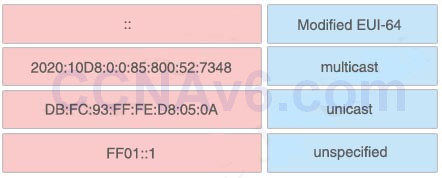
Answer:
+ Modified EUI-64: DB:FC:93:FF:FE:D8:05:0A
+ multicast: FF01::1
+ unicast: 2020:10D8:0:0:85:800:52:7348
+ unspecified: :: - Drag and drop the BGP components from the left onto the correct descriptions on the right.
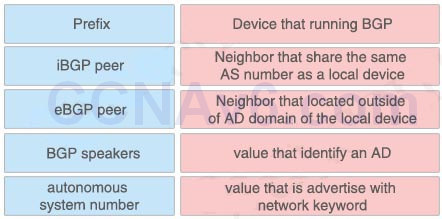
Answer:
+ Device that running BGP: BGP speakers
+ Neighbor that share the same AS number as a local device: iBGP peer
+ Neighbor that located outside of AD domain of the local device: eBGP peer
+ Value that identify an AD: Autonomous system number
+ Value that is advertise with network keyword: Prefix
